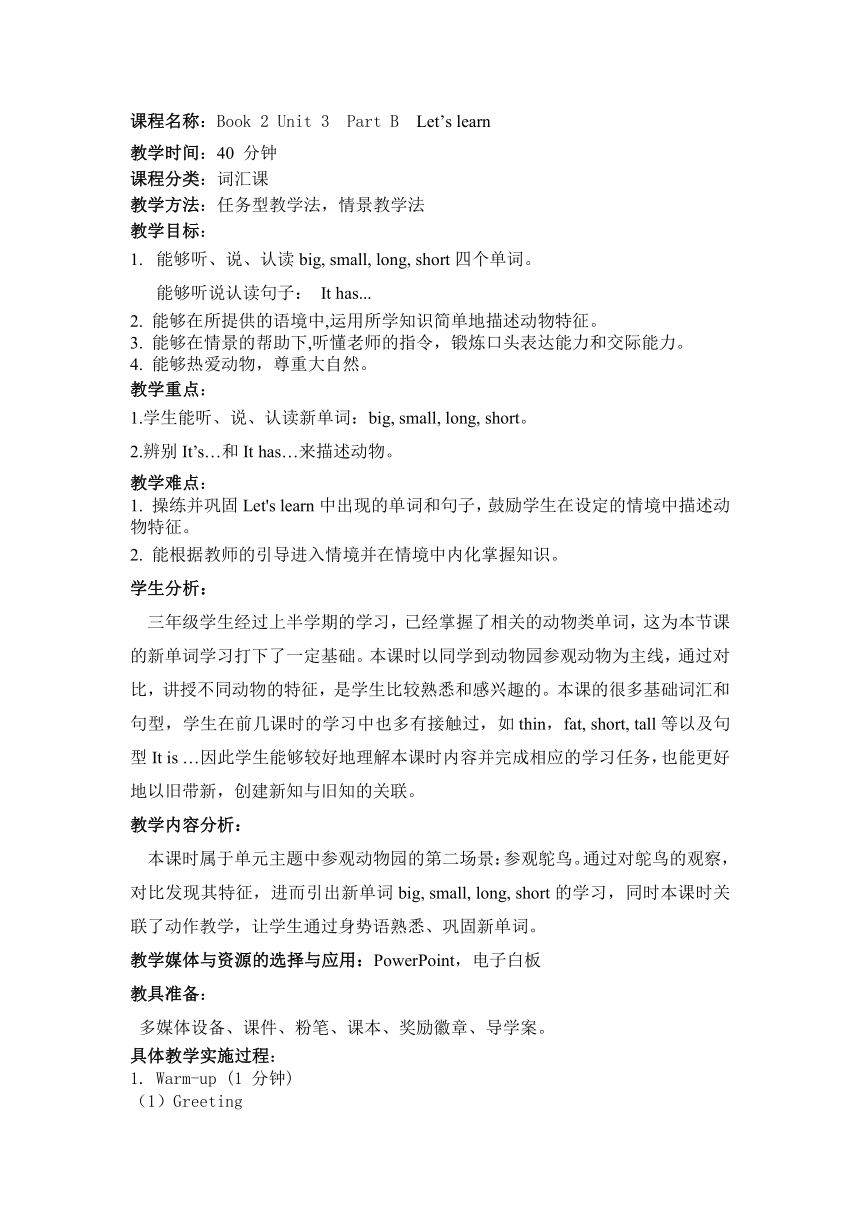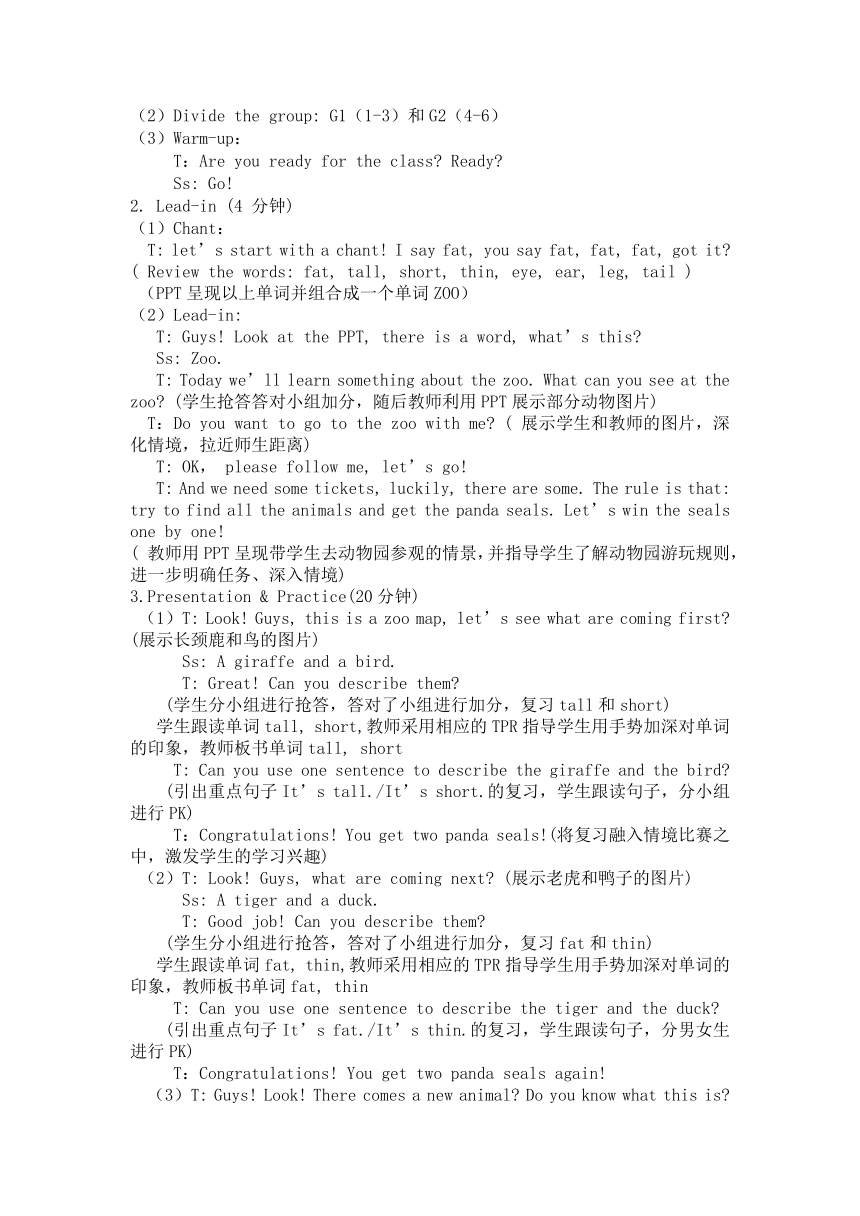Unit 3 At the zoo Part B let's learn 教学设计
文档属性
| 名称 | Unit 3 At the zoo Part B let's learn 教学设计 |  | |
| 格式 | docx | ||
| 文件大小 | 191.4KB | ||
| 资源类型 | 教案 | ||
| 版本资源 | 人教版(PEP) | ||
| 科目 | 英语 | ||
| 更新时间 | 2023-09-07 20:16:05 | ||
图片预览


文档简介
课程名称:Book 2 Unit 3 Part B Let’s learn
教学时间:40 分钟
课程分类:词汇课
教学方法:任务型教学法,情景教学法
教学目标:
能够听、说、认读big, small, long, short四个单词。
能够听说认读句子: It has...
2. 能够在所提供的语境中,运用所学知识简单地描述动物特征。
3. 能够在情景的帮助下,听懂老师的指令,锻炼口头表达能力和交际能力。
4. 能够热爱动物,尊重大自然。
教学重点:
1.学生能听、说、认读新单词:big, small, long, short。
2.辨别It’s…和It has…来描述动物。
教学难点:
操练并巩固Let's learn中出现的单词和句子,鼓励学生在设定的情境中描述动物特征。
能根据教师的引导进入情境并在情境中内化掌握知识。
学生分析:
三年级学生经过上半学期的学习,已经掌握了相关的动物类单词,这为本节课的新单词学习打下了一定基础。本课时以同学到动物园参观动物为主线,通过对比,讲授不同动物的特征,是学生比较熟悉和感兴趣的。本课的很多基础词汇和句型,学生在前几课时的学习中也多有接触过,如thin,fat, short, tall等以及句型It is …因此学生能够较好地理解本课时内容并完成相应的学习任务,也能更好地以旧带新,创建新知与旧知的关联。
教学内容分析:
本课时属于单元主题中参观动物园的第二场景:参观鸵鸟。通过对鸵鸟的观察,对比发现其特征,进而引出新单词big, small, long, short的学习,同时本课时关联了动作教学,让学生通过身势语熟悉、巩固新单词。
教学媒体与资源的选择与应用:PowerPoint,电子白板
教具准备:
多媒体设备、课件、粉笔、课本、奖励徽章、导学案。
具体教学实施过程:
1. Warm-up (1 分钟)
Greeting
Divide the group: G1(1-3)和G2(4-6)
Warm-up:
T:Are you ready for the class Ready
Ss: Go!
2. Lead-in (4 分钟)
(1)Chant:
T: let’s start with a chant! I say fat, you say fat, fat, fat, got it ( Review the words: fat, tall, short, thin, eye, ear, leg, tail )
(PPT呈现以上单词并组合成一个单词ZOO)
(2)Lead-in:
T: Guys! Look at the PPT, there is a word, what’s this
Ss: Zoo.
T: Today we’ll learn something about the zoo. What can you see at the zoo (学生抢答答对小组加分,随后教师利用PPT展示部分动物图片)
T:Do you want to go to the zoo with me ( 展示学生和教师的图片,深化情境,拉近师生距离)
T: OK, please follow me, let’s go!
T: And we need some tickets, luckily, there are some. The rule is that: try to find all the animals and get the panda seals. Let’s win the seals one by one!
( 教师用PPT呈现带学生去动物园参观的情景,并指导学生了解动物园游玩规则,进一步明确任务、深入情境)
3.Presentation & Practice(20分钟)
(1)T: Look! Guys, this is a zoo map, let’s see what are coming first (展示长颈鹿和鸟的图片)
Ss: A giraffe and a bird.
T: Great! Can you describe them
(学生分小组进行抢答,答对了小组进行加分,复习tall和short)
学生跟读单词tall, short,教师采用相应的TPR指导学生用手势加深对单词的印象,教师板书单词tall, short
T: Can you use one sentence to describe the giraffe and the bird
(引出重点句子It’s tall./It’s short.的复习,学生跟读句子,分小组进行PK)
T:Congratulations! You get two panda seals!(将复习融入情境比赛之中,激发学生的学习兴趣)
(2)T: Look! Guys, what are coming next (展示老虎和鸭子的图片)
Ss: A tiger and a duck.
T: Good job! Can you describe them
(学生分小组进行抢答,答对了小组进行加分,复习fat和thin)
学生跟读单词fat, thin,教师采用相应的TPR指导学生用手势加深对单词的印象,教师板书单词fat, thin
T: Can you use one sentence to describe the tiger and the duck
(引出重点句子It’s fat./It’s thin.的复习,学生跟读句子,分男女生进行PK)
T:Congratulations! You get two panda seals again!
(3)T: Guys! Look! There comes a new animal Do you know what this is
Ss: I don’t know.
T: It’s an ostrich. (教师带领学生跟读新单词ostrich)Let’s review the body parts.(学生分小组认读head, neck, body, tail, leg,答对加分)
用红色圆圈圈出鸵鸟身体和头的部分,引导学生思考、进行对比
T:What do you think of the head and the body
引出重点单词small, big的学习,教师采用相应的TPR指导学生用手势加深对单词的印象,学生分小组、分男女生、分个人跟读单词,教师板书单词small, big
T: Can you use one sentence to describe the head and the body
(引出重点句子It has a small head./It has a big body.的学习,学生跟读句子,分组进行PK)
提醒学生注意big的发音,字母i发/I/的音,并用一首chant 复习本单元语音知识。老师示范一遍,学生跟读一遍。
T:Then let’s write them.
教师带领学生拼读单词,并书写单词small, big
(4)T: Guys! Let’s look back to the ostrich again.
用红色圆圈圈出鸵鸟尾巴和腿的部分,引导学生思考、进行对比
T:What do you think of the tail and the leg
引出重点单词short, long的学习,教师采用相应的TPR指导学生用手势加深对单词的印象,学生分小组、分男女生、分个人跟读单词,教师板书单词short, long
T: Can you use one sentence to describe the tail and the leg
(引出重点句子It has a short tail./It has long legs.的复习,学生跟读句子,分组进行PK)
T:Then let’s write them.
教师带领学生拼读单词,并书写单词short, long
T:Congratulations! You get one panda seal!
4.Practice & Production(10分钟)
(1)T: Oh no! Some animals are missing, let’s help to find them.
(学生分小组进行抢答,答对了小组进行加分,根据描述猜测出panda,golden fish,bear)
根据描述猜测动物,进一步复习巩固新旧单词tall, short, fat, thin, big, small, long和句子It’s…/It has…学生在头脑里建立知识结构并与生活实际产生联系,近一步在情境中内化知识。
T:Congratulations! You get three panda seals!
There are still three animals, let’s work in groups and describe them. To see whether they are the animals at the zoo.
教师展示导学案上几张不同特征的动物图片(monkey, elephant, rabbit),利用思维导图的形式呈现句型It’s…/It has …,为降低难度,给出相应的提示语和参考单词选择填空。将导学案发给学生,指导学生进行小组活动,三分钟之后小组进行展示。
直观感受
描述比较
G1和G2同学进行PK,展示自己所讨论出来的描述性句子,言之有理均可加分。
T:Congratulations! You have found back all these animals, you can get all the panda seals!
5.Summary(4分钟)
(1)Group winner:综合小组得分情况评选出最佳小组并获得熊猫徽章奖励
(2)Summary:
T: Today we have learnt how to describe animals: It’s …and It has… do you know their differences
(教师展示两组句型的区别,并给学生时间在书本上做好相应笔记)
T: As the time is limited, our class is going to come to an end. Today we’ve learnt four new words:big, small, long, short and two sentences: It’s…/It has … besides short has two meanings: 短的;矮的
In the end, I want to say our world is colorful and beautiful, we should love and protect animals!
(教师总结本课时所学习的内容,并进行情感教育和课堂升华,倡导学生爱护动物。)
6.Homework(1分钟)
T: Today’s homework is to draw a zoo and describe the animals.
(教师呈现作业例子,融合美术学科加深学生对重难点知识的印象)
T: The class is over, thank you for your cooperation. Have a good time!
7.Blackboard design
教学评价与反思:
本课时贯彻了情境教学法,比较新颖,充分地调动了学生的学习兴趣和积极性,不过纵观下来本课时教学内容偏少,教学流程重复性较大,分层教学还有待加强。教师在板书环节应注意规范,先板书重点句型让学生有框架去运用。注重产出训练时教师对学生的鼓励和表扬,另外教师在小组合作和做笔记环节应加强巡视和指导,确保书写的规范性。作业的布置应考虑学生的能力,适当减少难度,注意分层训练。
教学时间:40 分钟
课程分类:词汇课
教学方法:任务型教学法,情景教学法
教学目标:
能够听、说、认读big, small, long, short四个单词。
能够听说认读句子: It has...
2. 能够在所提供的语境中,运用所学知识简单地描述动物特征。
3. 能够在情景的帮助下,听懂老师的指令,锻炼口头表达能力和交际能力。
4. 能够热爱动物,尊重大自然。
教学重点:
1.学生能听、说、认读新单词:big, small, long, short。
2.辨别It’s…和It has…来描述动物。
教学难点:
操练并巩固Let's learn中出现的单词和句子,鼓励学生在设定的情境中描述动物特征。
能根据教师的引导进入情境并在情境中内化掌握知识。
学生分析:
三年级学生经过上半学期的学习,已经掌握了相关的动物类单词,这为本节课的新单词学习打下了一定基础。本课时以同学到动物园参观动物为主线,通过对比,讲授不同动物的特征,是学生比较熟悉和感兴趣的。本课的很多基础词汇和句型,学生在前几课时的学习中也多有接触过,如thin,fat, short, tall等以及句型It is …因此学生能够较好地理解本课时内容并完成相应的学习任务,也能更好地以旧带新,创建新知与旧知的关联。
教学内容分析:
本课时属于单元主题中参观动物园的第二场景:参观鸵鸟。通过对鸵鸟的观察,对比发现其特征,进而引出新单词big, small, long, short的学习,同时本课时关联了动作教学,让学生通过身势语熟悉、巩固新单词。
教学媒体与资源的选择与应用:PowerPoint,电子白板
教具准备:
多媒体设备、课件、粉笔、课本、奖励徽章、导学案。
具体教学实施过程:
1. Warm-up (1 分钟)
Greeting
Divide the group: G1(1-3)和G2(4-6)
Warm-up:
T:Are you ready for the class Ready
Ss: Go!
2. Lead-in (4 分钟)
(1)Chant:
T: let’s start with a chant! I say fat, you say fat, fat, fat, got it ( Review the words: fat, tall, short, thin, eye, ear, leg, tail )
(PPT呈现以上单词并组合成一个单词ZOO)
(2)Lead-in:
T: Guys! Look at the PPT, there is a word, what’s this
Ss: Zoo.
T: Today we’ll learn something about the zoo. What can you see at the zoo (学生抢答答对小组加分,随后教师利用PPT展示部分动物图片)
T:Do you want to go to the zoo with me ( 展示学生和教师的图片,深化情境,拉近师生距离)
T: OK, please follow me, let’s go!
T: And we need some tickets, luckily, there are some. The rule is that: try to find all the animals and get the panda seals. Let’s win the seals one by one!
( 教师用PPT呈现带学生去动物园参观的情景,并指导学生了解动物园游玩规则,进一步明确任务、深入情境)
3.Presentation & Practice(20分钟)
(1)T: Look! Guys, this is a zoo map, let’s see what are coming first (展示长颈鹿和鸟的图片)
Ss: A giraffe and a bird.
T: Great! Can you describe them
(学生分小组进行抢答,答对了小组进行加分,复习tall和short)
学生跟读单词tall, short,教师采用相应的TPR指导学生用手势加深对单词的印象,教师板书单词tall, short
T: Can you use one sentence to describe the giraffe and the bird
(引出重点句子It’s tall./It’s short.的复习,学生跟读句子,分小组进行PK)
T:Congratulations! You get two panda seals!(将复习融入情境比赛之中,激发学生的学习兴趣)
(2)T: Look! Guys, what are coming next (展示老虎和鸭子的图片)
Ss: A tiger and a duck.
T: Good job! Can you describe them
(学生分小组进行抢答,答对了小组进行加分,复习fat和thin)
学生跟读单词fat, thin,教师采用相应的TPR指导学生用手势加深对单词的印象,教师板书单词fat, thin
T: Can you use one sentence to describe the tiger and the duck
(引出重点句子It’s fat./It’s thin.的复习,学生跟读句子,分男女生进行PK)
T:Congratulations! You get two panda seals again!
(3)T: Guys! Look! There comes a new animal Do you know what this is
Ss: I don’t know.
T: It’s an ostrich. (教师带领学生跟读新单词ostrich)Let’s review the body parts.(学生分小组认读head, neck, body, tail, leg,答对加分)
用红色圆圈圈出鸵鸟身体和头的部分,引导学生思考、进行对比
T:What do you think of the head and the body
引出重点单词small, big的学习,教师采用相应的TPR指导学生用手势加深对单词的印象,学生分小组、分男女生、分个人跟读单词,教师板书单词small, big
T: Can you use one sentence to describe the head and the body
(引出重点句子It has a small head./It has a big body.的学习,学生跟读句子,分组进行PK)
提醒学生注意big的发音,字母i发/I/的音,并用一首chant 复习本单元语音知识。老师示范一遍,学生跟读一遍。
T:Then let’s write them.
教师带领学生拼读单词,并书写单词small, big
(4)T: Guys! Let’s look back to the ostrich again.
用红色圆圈圈出鸵鸟尾巴和腿的部分,引导学生思考、进行对比
T:What do you think of the tail and the leg
引出重点单词short, long的学习,教师采用相应的TPR指导学生用手势加深对单词的印象,学生分小组、分男女生、分个人跟读单词,教师板书单词short, long
T: Can you use one sentence to describe the tail and the leg
(引出重点句子It has a short tail./It has long legs.的复习,学生跟读句子,分组进行PK)
T:Then let’s write them.
教师带领学生拼读单词,并书写单词short, long
T:Congratulations! You get one panda seal!
4.Practice & Production(10分钟)
(1)T: Oh no! Some animals are missing, let’s help to find them.
(学生分小组进行抢答,答对了小组进行加分,根据描述猜测出panda,golden fish,bear)
根据描述猜测动物,进一步复习巩固新旧单词tall, short, fat, thin, big, small, long和句子It’s…/It has…学生在头脑里建立知识结构并与生活实际产生联系,近一步在情境中内化知识。
T:Congratulations! You get three panda seals!
There are still three animals, let’s work in groups and describe them. To see whether they are the animals at the zoo.
教师展示导学案上几张不同特征的动物图片(monkey, elephant, rabbit),利用思维导图的形式呈现句型It’s…/It has …,为降低难度,给出相应的提示语和参考单词选择填空。将导学案发给学生,指导学生进行小组活动,三分钟之后小组进行展示。
直观感受
描述比较
G1和G2同学进行PK,展示自己所讨论出来的描述性句子,言之有理均可加分。
T:Congratulations! You have found back all these animals, you can get all the panda seals!
5.Summary(4分钟)
(1)Group winner:综合小组得分情况评选出最佳小组并获得熊猫徽章奖励
(2)Summary:
T: Today we have learnt how to describe animals: It’s …and It has… do you know their differences
(教师展示两组句型的区别,并给学生时间在书本上做好相应笔记)
T: As the time is limited, our class is going to come to an end. Today we’ve learnt four new words:big, small, long, short and two sentences: It’s…/It has … besides short has two meanings: 短的;矮的
In the end, I want to say our world is colorful and beautiful, we should love and protect animals!
(教师总结本课时所学习的内容,并进行情感教育和课堂升华,倡导学生爱护动物。)
6.Homework(1分钟)
T: Today’s homework is to draw a zoo and describe the animals.
(教师呈现作业例子,融合美术学科加深学生对重难点知识的印象)
T: The class is over, thank you for your cooperation. Have a good time!
7.Blackboard design
教学评价与反思:
本课时贯彻了情境教学法,比较新颖,充分地调动了学生的学习兴趣和积极性,不过纵观下来本课时教学内容偏少,教学流程重复性较大,分层教学还有待加强。教师在板书环节应注意规范,先板书重点句型让学生有框架去运用。注重产出训练时教师对学生的鼓励和表扬,另外教师在小组合作和做笔记环节应加强巡视和指导,确保书写的规范性。作业的布置应考虑学生的能力,适当减少难度,注意分层训练。
